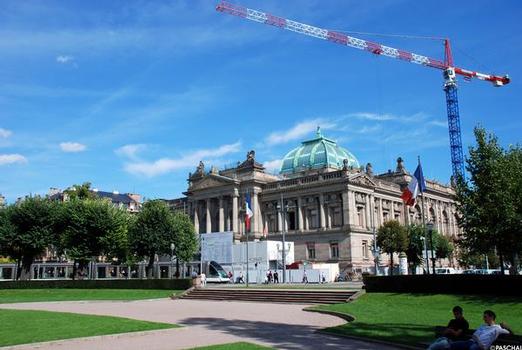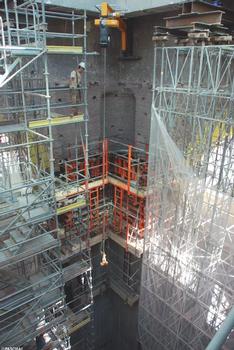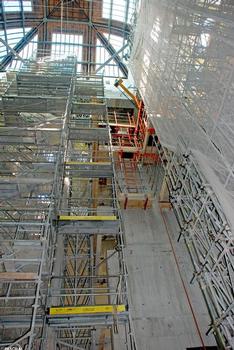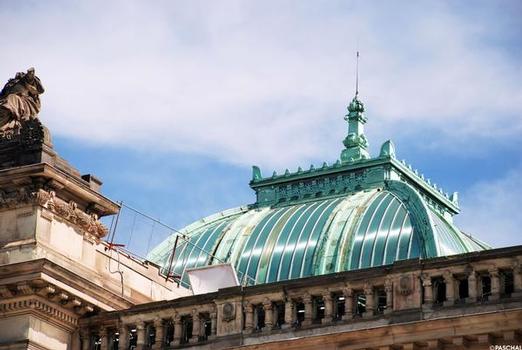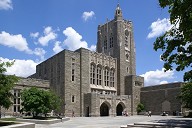Creative designs for floating cupola
In France, numerous major buildings are located on the Place de la République. In Strasbourg, one of these is very large and circular in shape. It is surrounded by the Prefecture of the Département, the Ministry of Culture and Communication, and the Minstry of Finance – among other buildings, including the Bibliothèque Nationale et Universitaire.
Media
In the Franco-German War (1870-1871), the Dominikanerkirche church in Strasbourg was destroyed by Prussian artillery fire – along with its side wing which housed the metropolitan library and metropolitan archives; as a result, many irreplaceable historical documents were lost. On this site, the New Church (Temple Neuf) was erected. By contrast, the new library was built in an area which at the time was called the Kaiserplatz. According to drafts by the architects Skjold Neckelmann and August Hartel, it was built between 1889 and 1894, in the style of historicism. It had two simultaneous functions: as a national library and a university library. Over time, it became the second-largest library in France.
However, the structural over 100 years old substance of this building which stands under monument conservation was increasingly unable to meet the modern requirements in terms of structural engineering, fireproofing etc. So it was decided to implement a complete refurbishment in which the exterior front, the roof and numerous inner structures were to remain intact, and this circumstance significantly complicated this undertaking. A total construction cost of € 61 million was proposed.
Construction work on existing buildings
The building complex should be gutted to the greatest possible extent. In the process, no damage may occur to the fronts. This means that any access by machines, people and material must indeed be made by way of the existing access routes – which are, in principle, not designed for this type of access. The consortium consisting of Urban BTP (Illkirch) und Demathieu & Bard (branch Duppigheim) then addressed this task. Both companies were already founded in the 19th century, and are among the major construction companies in France; Urban is affiliated with the Vinci Group (over 160,000 employees).
In addition, the very tight available space on the premises as a whole further complicate the matter, considering that the premises are just a few metres wider than the building itself. This space is largely taken up by construction containers as well as the construction vehicles carrying materials to and from the site. The surrounding streets were not to be blocked and traffic not impeded. This requires the particularly painstaking planning of logistics and deliveries whenever they are needed - and at that precise moment. A large crane which can transport even heavy loads to far-away locations then ensures a constant flow of replacement supplies.
The floating cupola
The most difficult part of the renovation involves the gutting and support of the middle structure – crowned by the cupola which can be seen from afar. Here, too, access from above is impossible. The cupola should fill the inside with sunlight – all the way down to the basement floor. However, without sufficient structural support, the cupola threatened to topple into the interior! All work takes place under extremely difficult conditions which make typical construction work virtually impossible:
- The available space is so limited that typical working-platforms cannot be applied to the formwork. Nevertheless, French law mandates safety installations which far surpass the given safety requirements in comparison to Germany.
- It is impossible for a crane to extend through the cupola. Nevertheless, heavy-duty concrete work must be performed up to a height of approx. 24 m.
So, under these circumstances, what is the best course of action for maintaining the greatest possible level of efficiency?
- The structurally-ineffective building components were removed, and a sub-structure (approx. 24 m high) was built from four towers to absorb the load of the cupola. After that, some space could be created.
- On the four corners of the middle structure (at the greatest possible height - that is to say, below the cupola's support structure and thereby in a less-than-ideal position), one pivot arm each of a hoist crane is installed. The maximal load is a mere 1.5 t.
- A tetragonal binding beam made of in-situ concrete was constructed on which the cupola rests. The total weight of this structure alone amounts to more than 600 tonnes. It requires two weeks for the concrete to achieve its final load capacity.
- On the corners which have remained clear, L-shaped concrete columns with a 32-mm concrete reinforcement rise to face the binding beam. These should ultimately carry the total load. Between the columns and the supporting walls, there is a spacing of merely 1.5 m.
- As soon as the structural/design-engineering connection to the binding beam is successfully completed, the supporting scaffoldings will be removed. With that, the actual interior work can start.
Concrete and formwork works
The performance of concrete work proved to be very highly sophisticated under these circumstances. In all of the planning and tender phases, those who considered the project practically impossible or unrealistically expensive in its intended form "jumped ship". Ultimately, PASCHAL proved to be the only service providers who had a firm and durable concept.
- The binding beam is 0.80 m wide, 1.10 m high and square-shaped (14.58 m on each side). In this context, the edges of the lengthwise sides are 1.45 m longer than those on the transverse sides, which gives the structure an approximate "H" shape. The formwork is built with horizontally-positioned elements of the LOGO.alu formwork system (up to 2.70 m long) which is very simple and easy to handle, due to its low weight – this is a necessary prerequisite in the tight confines of the dome. The LOGO.alu can be adjusted to the required length by 1-cm intervals - this renders the nuisance residual by site fillers unnecessary. As supporting system PASCHAL Deck was used.
- As a formwork system for the L-shaped columns (3.80 x 3.00 m and 0.60 m thick), the LOGO.3 was selected. The LOGO.3 absorbs 70 kN/m² of fresh-concrete pressure according to DIN 18218 - with its profiled flat-steel frame particularly suited to narrow conditions. One height cycle was 2.94 m high; there were seven of these, and the eighth and/or the subsequent cycle was planned once again with the LOGO.alu. From the fourth height work cycle, the widths are a mere 3.00 x 3.00m, which was also readily apparent in the planning process, which had also made its mark on may aspects of the planning - since tie points, element dimensions and work scaffoldings must be pre-set accordingly. The LOGO.3 was used as a climbing formwork with a suspended scaffold. A work cycle was done every two days. In total, two formwork sets were applied (each to diagonally-opposed columns).
- There is no such thing as a serial work scaffolding for formwork which fits between the narrow walls and also fulfils the highest of safety requirements. So the PASCHAL structural Design Division developed two completely new climbing systems (one each for the front side and the rear side), which only have 1.05 m wide brackets (in which attached ladders are integrated) Ultimately, the construction oversight authorities were not the only ones enthused by this - it was even possible for the outside to (despite the rather modest performance of the small crane) to shift the formwork along with the work scaffolding, the climbing unit and a cane set - which in turn increased the level of efficiency even more.
The end of this formwork "detective story"
Christian Bordier, the formwork consultant from PASCHAL, is absolutely thrilled. As he says, a construction site - particularly one with these requirements - is anything but child's play, and there were constant modifications to be made, as well as a need for co-ordination, the occurrence of unforeseen difficulties - and even some smaller setbacks. "That is definitely a part of this process," he says. "It always happens this way when one dares to try something new or difficult. " No rewards without effort! As he maintains: "So little formwork, so much to consider - that's good for your head!" So this is how the result - which he describes as "art" - turned out, perfectly, only due to the co-ordination between all parties involved.
References
Structure Types
- About this
data sheet - Product-ID
6266 - Published on:
15/05/2013 - Last updated on:
30/01/2016

